The Art of Francesca Woodman: Haunting, Evocative, Personal
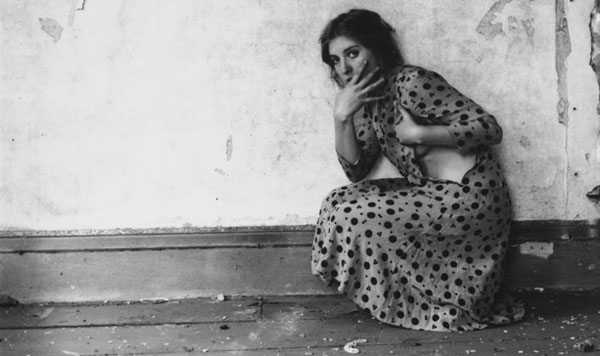
On January 9, 1981, at the age of 22, Francesca Woodman leapt to her death from the window of her New York apartment.
She did not leave a suicide note, but in a letter to her best friend written shortly before she died, she said,
“My life at this point is like very old coffee-cup sediment and I would rather die young leaving various accomplishments, ie some work, my friendship with you, some other artefacts intact, instead of pell-mell erasing all of these delicate things.” 1
Born in April 1958 to George and Betty Woodman, both of whom are working artists themselves, the pressures on Francesca to become well-known and successful as an artist were enormous. After 22 short years of life and the production of approximately 800 images, 2 it seemed that Woodman had succumbed to the stresses associated with breaking into the art world.
Though the sublimely gifted photographer’s early death is indeed tragic, this piece is not about her suicide, nor should others’ interpretations of her work be. While the inner demons that lead her to her death were most certainly a factor that influenced her art, viewers would be remiss to explicate her images through the lens of her early suicide.
However, like her work, Woodman herself also had a spectral quality. She passed through earthly life quickly and quietly, like a ghost, and her work is so puzzling and widely debated that she has almost become a phantom in the minds of others, as if she may not have existed at all. Woodman was not famous while she was alive, and the art world has almost mythologized her after her death.
Francesca Woodman: A Life

It is difficult not to read Woodman’s images as alluding to a troubled state of mind and containing autobiographical qualities. Regardless, those who appreciate Woodman’s photographs are often compelled to seek out biographical information, wondering “who was this mysterious, lost young woman?”
Francesca Woodman was born on April 3, 1958 in Boulder, Colorado to ceramicist Betty Woodman and painter/photographer George Woodman. 3 Her mother was Jewish, and her father was of Protestant heritage, but “the real family religion was art.” 4 Thus, “art was a morally as well as spiritually demanding calling for Francesca, one that she pursued with all the idealism and self-doubt of a hopelessly romantic teenager.” 5 Having artists for parents made success imperative for young Francesca, for whom obscurity was like a living hell.
Woodman attended a private boarding high school in Massachusetts, where she first began developing her artistic skills. She spent summers at her family’s home in Italy and began attending the Rhode Island School of Design in Providence, RI in 1975. 6
“She was kooky, and at first I didn’t want to be anywhere near her,” Woodman’s friend Betsy Berne told Rachel Cooke of The Guardian. “We were in the same dorm, and I couldn’t get away from her. She seemed to have been born in the wrong century – she was totally outside pop culture; she never watched TV; she couldn’t have cared less about music. But if she wanted something, she was going to get it…she was very loyal and intense. She was the kind of person you either loved or hated.” 7
During her third year of college, she traveled to Rome as part of a RISD honors program before returning to America in 1978 and graduating. The following year, Woodman moved to New York City to pursue a career in photography. She began sending her portfolio out to professional photographers, with no success 8
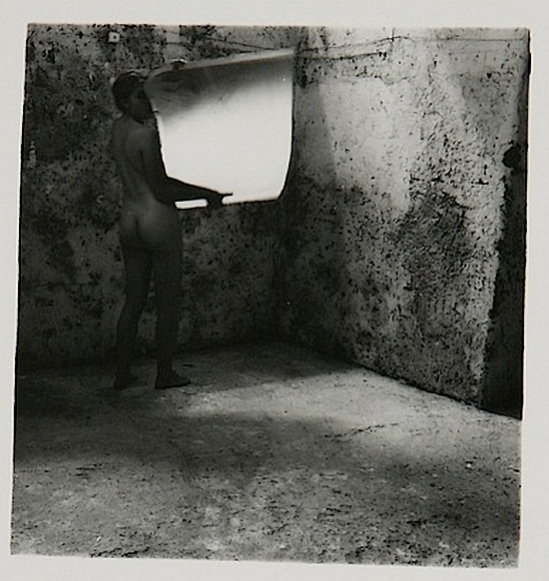
She attempted suicide for the first time in the fall of 1980. She survived, received psychiatric treatment, and moved back in with her parents, who were also residing and working in Manhattan at the time. 9 Then, a grant application was denied, her bicycle was stolen, a romance went south, and Woodman’s parents suspect that she had stopped taking her medication. 10
Some have linked Woodman’s suicide to her failed grant application, but those who were close to Woodman dispute this.
“She had an illness: depression. That’s all there is to it,” said Betsy Berne. 11
Self-Presentation and Interpretations
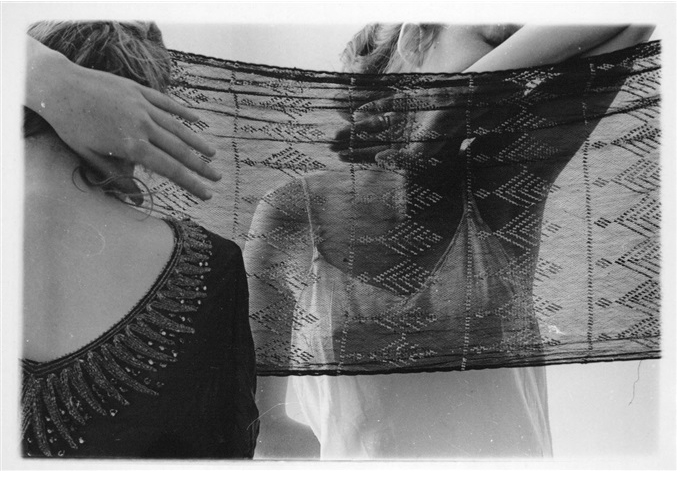
Woodman’s work consists mainly and most notably of ghostly self-portraits, most of which are nude, though she also experimented with angles formed by legs, pleated fabric, unhinged doors, window ledges, and the like. Her art is neurotic, clever, erotic, ironic, and in some cases, painfully honest. Some of her photographs even include playful visual jokes.
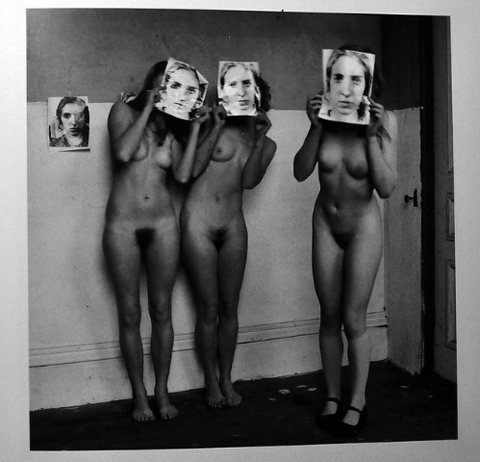
Critics can’t seem to agree on the meaning or purpose of her images. Some have compared her to surrealist photographers like Man Ray, while others, like American critic Rosalind Krauss, have hailed her as a feminist hero who was “exploring the ways in which women are forced to conceal and disguise their true selves.” 12 Her images are also deeply personal, lending them an autobiographical quality, which is why their interpretation is often based on psychoanalysis and colored by her suicide.
While Woodman’s images are, ostensibly, self-presentation, many would argue that she is not their sole subject, that there is a larger purpose that isn’t quite so obvious.
Some young people feel that her images are universal in nature, describing the struggles of growing up and finding oneself. They believe that her work is talking about them.
Others feel that the artist herself and her desire to disappear are the driving force behind the work.
It is difficult to fully understand Woodman’s art, which is rich in symbolism that the artist did not live long enough to explain (or perhaps even to totally comprehend herself). All we truly have as viewers and admirers are a brief biography, some critical guesswork, and how these images make us feel.
Her evocative photographs are best appreciated with a focus on the latter.
Seduced
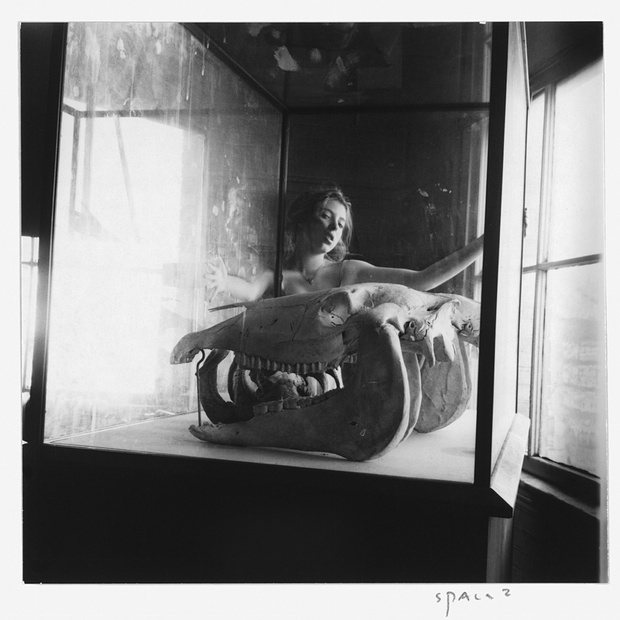
Woodman’s images are gently erotic rather than frankly pornographic, making them seductive without soliciting a sexual relationship with the viewer.
The more I look at her work, the more Woodman seems like a long lost lover, one whose curves I have known time and time again but who evokes loving memories rather than lustful ones. As I focus more closely on each individual image, I feel as though I am holding her in my arms. But if I linger for too long, she slips away again like a shadow into shade.
Indeed, Francesca Woodman was beautiful, although not unbelievably so, and she was more than just a pretty girl who used her looks to produce work that people would want to look at.
Francesca once told her told her parents that self-inclusion in her art was a matter of “convenience.” She was always available to herself, whereas finding a model and prompting her to look and stand and sit every which way could waste a lot of time and would not ensure achievement of the desired effect. 13
In some images, Woodman pairs seduction with humor, irony, or brutal honesty to beguile viewers. It is those images that showcase Woodman’s technical skill and compositional talent. She had creative ideas the likes of which one would be hard pressed to find anywhere else.
Viewers of all sorts are drawn to her work, even if they have never seen it before. It is seductive because she is beautiful while still leaving much to the imagination, because she is an enigma whose incredible young talent we don’t quite understand, because she is a suicide and, to be frank, we all want to die sometimes.
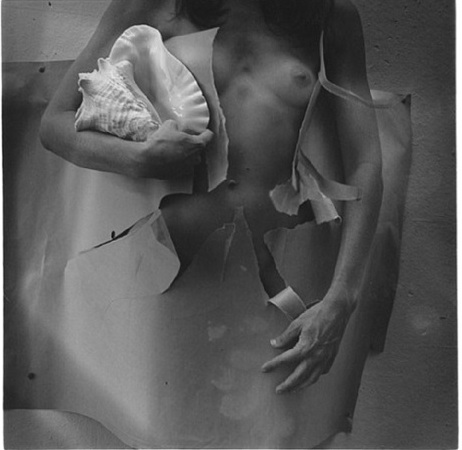
Amused
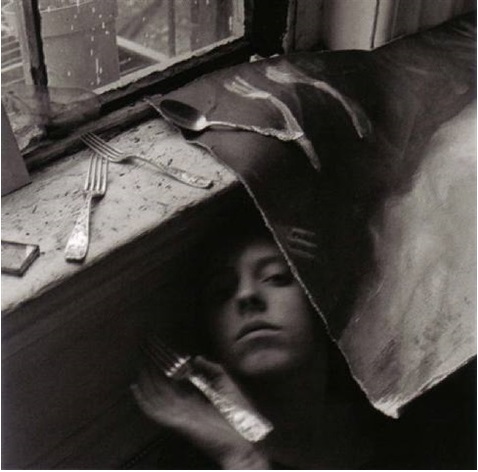
Though many interpret Francesca’s images with the idea that they’re all about death and disappearance, Betty Woodman has denounced this explication as a “basic fallacy.” 14 Woodman’s lighthearted sense of humor is apparent in her work, which is interspersed with witty titles, playful visual jokes, and oddly funny subject matter. The generous helping of humor in her work is often baffling to those who view her art through an autobiographical lens. Clearly, this young woman was in a dark place when she produced these images, so what purpose does this jocularity serve and where did it come from?
Many of Woodman’s funny images were showcased in the Zigzag exhibition, which was shown in Victoria Miro, Mayfair in 2014. 15
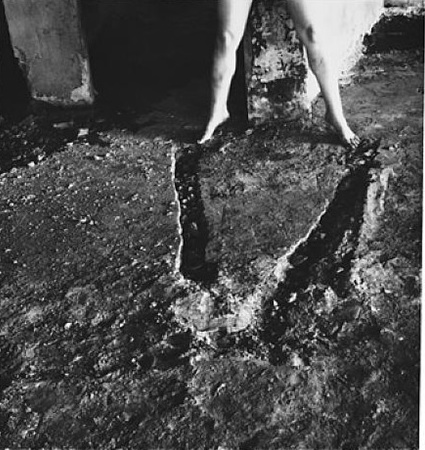
She has delighted viewers with such images as a fingerless pair of “gloves” made from tree bark and modeled with her own hands, a disembodied pair of legs mirroring a charred v-shaped groove in the ground where she “fell to earth,” and a face and hand peeking out from beneath a tablecloth and surrounded by silverware at lunchtime.
Some of her images pair wit and irony with spooky aspects to produce an odd, dark humor. Others are so subtle in their humor that viewers may not recognize them as funny at first.
It is these nuances that make Woodman’s art deeply multi-faceted. Those who seek to pigeonhole all of her images into one particular explication often find pieces that do not fit into their theory.
This is what makes the work so complex.
Haunted
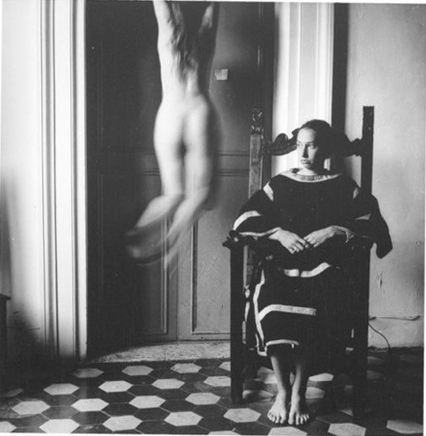
Perhaps the most apparent aspect of Woodman’s images is a haunting, ghostly quality.
Many of her photographs were taken using a slow shutter speed, meaning that the camera captured her movements, which made her appear as a blur. 16 As a result, her “concealed figures” 17 are reminiscent of ghosts or corpses, and many of her images seem to have been taken by a camera that was left in the presence of specters in a haunted house or a graveyard. There are no modern buildings in her work, only crumbling, dust-covered ruins “whose disintegrating forms evoke the wrecks admired by the eighteenth- and nineteenth-century Gothic revivalists often cited as [some of Woodman’s] major influences.” 18 The delicate grays that shade her images are wispy, as well, adding to the haunted tone and showing the artist’s keen eye for light, shadow, and form.
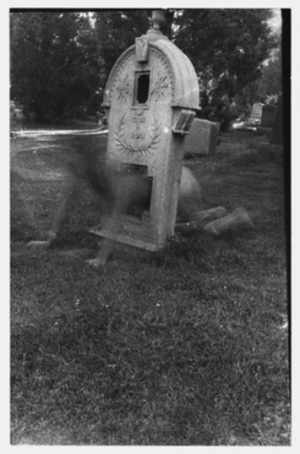
In some of her works produced during her time as a RISD student, her entire form appears as fog, moving through tombstones and evaporating inside of fireplaces. Woodman referred to this series as “ghost pictures.” 19 In others, Woodman’s surroundings emit a strange, ethereal light, seeming to give off otherworldly energy.
At first glance, her images seem deathly, even funeral, which has led some to interpret her work as the product of a lifetime of anticipating her untimely disappearance.
Or perhaps it is the visual style of a feminist photographer.
Regardless of how this aspect of her work is interpreted, there is no escaping how the images are bound to haunt viewers, as if leading them prematurely into the afterlife.
Legacy
Woodman’s art was introduced to the public in 1986, and it immediately attracted a great deal of attention. 20 Since then, her potency has only grown over time, and she has attracted a large following, particularly among young people. Some have even thought of her art as “a girl’s visual equivalent of Catcher in the Rye.” 21 Her work has also been appreciated by major art critics, and famous photographers like Cindy Sherman have cited her work as an influence on their own. 22 Though only a quarter of the 800 images that Woodman produced over her lifetime have been viewed by the public 23, her work has seen all of the critical acclaim and public success that Woodman could have hoped for while she was alive…and then some.
Works Cited
- Kate Salter, “Blurred genius: the photographs of Francesca Woodman.” The Telegraph, (May 2012). ↩
- Elizabeth Gumport, “The Long Exposure of Francesca Woodman.” The New York Review of Books, (Jan. 2011). ↩
- “Francesca Woodman.” Artnet.com, (n.d.). ↩
- Ken Johnson, “Exposing the Body, Baring the Soul.” The New York Times, (March 2012). ↩
- Ken Johnson, “Exposing the Body, Baring the Soul.” The New York Times, (March 2012). ↩
- “Francesca Woodman.” Artnet.com, (n.d.). ↩
- Rachel Cooke, “Searching for the real Francesca Woodman.” The Guardian, (Aug. 2014). ↩
- “Francesca Woodman.” Artnet.com, (n.d.). ↩
- Kate Salter, “Blurred genius: the photographs of Francesca Woodman.” The Telegraph, (May 2012). ↩
- Elizabeth Gumport, “The Long Exposure of Francesca Woodman.” The New York Review of Books, (Jan. 2011). ↩
- Rachel Cooke, “Searching for the real Francesca Woodman.” The Guardian, (Aug. 2014). ↩
- Kate Salter, “Blurred genius: the photographs of Francesca Woodman.” The Telegraph, (May 2012). ↩
- Rachel Cooke, “Searching for the real Francesca Woodman.” The Guardian, (Aug. 2014). ↩
- Rachel Cooke, “Searching for the real Francesca Woodman.” The Guardian, (Aug. 2014). ↩
- Rachel Cooke, “Searching for the real Francesca Woodman.” The Guardian, (Aug. 2014). ↩
- Kate Salter, “Blurred genius: the photographs of Francesca Woodman.” The Telegraph, (May 2012). ↩
- Kate Salter, “Blurred genius: the photographs of Francesca Woodman.” The Telegraph, (May 2012). ↩
- Elizabeth Gumport, “The Long Exposure of Francesca Woodman.” The New York Review of Books, (Jan. 2011). ↩
- Elizabeth Gumport, “The Long Exposure of Francesca Woodman.” The New York Review of Books, (Jan. 2011). ↩
- Rachel Cooke, “Searching for the real Francesca Woodman.” The Guardian, (Aug. 2014). ↩
- Ken Johnson, “Exposing the Body, Baring the Soul: Francesca Woodman at Guggenheim Museum.” The New York Times, (March 2012). ↩
- Kate Salter, “Blurred genius: the photographs of Francesca Woodman.” The Telegraph, (May 2012). ↩
- Elizabeth Gumport, “The Long Exposure of Francesca Woodman.” The New York Review of Books, (Jan. 2011). ↩
What do you think? Leave a comment.










Francesca’s photos were so ahead of their time… and yes… being copied in fashion magazines today. She was a genius in her craft and died way too young…
The short films that she made were quite intriguing.
She’s become my favorite artist lately. She was so interesting and died so young, I don’t know if I’m more captivated by her art or by her. I’m not sure that you can separate the two, anyway, thank you for the article.
The article is as beautiful as the art! It takes a deft hand to capture such emotion that is projected from such deeply personal art. This is not only a great introduction to the artist but it is a great example of how to write about art!
Thank you so much!
Quite an intriguing article. You have managed to capture the appealing qualities of Woodman’s work in your writing.
Francesca Woodman did some jaw dropping self portraits in b&w. I personally loved the one with wings.
I do love her photography!
22! So sad. The work she never did. That we’ll never see. Tragic.
I last saw some of her work at the Photographers’ Gallery nearly 15 years ago (I think) and I’ve had it on the brain since.
“Haunting” is an overused adjective, but there really is none better to describe her work.
They’re all great and some of them are genuinely amazing.
An angel who forgot to use her wings when she jumped from her apartment.
Her pictures are so haunting. So many ones where she’s melding into the background – like the one where she’s part of a wall. It makes me wonder if she wanted to disappear. She’s fascinating.
A lot of people have made that observation. Her mother has insisted that she wasn’t looking to disappear, but it’s really difficult to say for sure.
She certainly is fascinating!
She definitely wanted to disappear.
That’s your opinion. It’s impossible to definitively say.
Watch The Woodman’s recently. I was inspired to learn more about her and her work.
She was incredible. And to think what she could have done had she lived longer. I saw an exhibit at the SFMOMA a few years ago and the images stayed with me for a while.
Does somebody know how and if I can find a photobook with the pictures of Francesca Woodman?
In a speclised book shop…
Or online, perhaps.
Amazon has several collections of her work.
self portrait of a true artist…
breath taking surreallistic manifestations of beauty
I’m very much a fan of hers now. Beautiful photographs.
that was a great article!
I have never heard of her before this article. But this was fascinating. Thank you for introducing me to her so succinctly.
She is very cool. A lot edgier than julia Margaret Cameron (whose work I admire very much).
Definitely edgier, although inspired by a similar aesthetic. Julia Margaret Cameron is admirable for a whole host of her own reasons.
Thanks for the observation!
Wow, just incredible stuff.
I like some of her work, but she s ploughing from the same field as Duanne Michaels to me.
Yes, Duane Michals has been cited as a key influence on Woodman’s art. His work is incredible!
But if you ask me, “ploughing from the same field” as Duane Michals does not make Woodman any less outstanding or deserving of acclaim. Drawing inspiration from those who have already earned critical praise is a vital part of one’s development as an artist. Nobody obtains an artistic vision out of the blue. It is the result of appreciating others’ work in addition to developing one’s own individual message.
No artist, recent or past, is 100% original.
She is one of the most talented photographer I have ever seen.
It’s very sad that she committed suicide. A genius.
She’s been on my to investigate list for a while. I love it.
Great work and despite rather than because of the artist’s early demise.
I had seen a couple of the Francesca’s art works before, but I never though much about the women behind them.
I would say her works are haunting indeed, hauntingly beautiful. Seems her life was that way as well.
Thank you for such a wonderful article and introducing me to the lady behind the art. I will defiantly be looking into more of her works.
Inspired and inspiring stuff!
The photographs are astonishing.
This is very much photography as creative composition, an exhilarating veer away from the documentary tradition, or ‘the decisive moment’ (as great as they can be, in themselves).
Even as a self diagnosed art junkie, I have never come across Francesca’s work. I thank you for such an exposure, but also an in depth analysis of her art, and her as a person. Very informative piece.
Her work is beautiful.
Your article actually introduced me to Woodman’s work. Her photographs have a contemporary yet timeless quality that is reminiscent of Dali. The art world lost an amazing artist.
Incredible piece. I had no idea who Francesca Woodman was, and I’m going to look more into it now.
The tone for this was thematically consistent: haunting and beautiful, this stood out the most:
“The more I look at her work, the more Woodman seems like a long lost lover, one whose curves I have known time and time again but who evokes loving memories rather than lustful ones.”
Thanks for such an interesting article and complete retrospective on an artist that I personally didn’t know at all! Always great to discover new artists and new works on The Artifice! 🙂
Intriguing and haunting. Her inner demons took her life and yet here she is reborn in the fame of her photos, as if asking for us to see HER. Beautiful. Thanks for sharing!
This is an interesting article about an artist I had not known about until now. That she is near your age as a budding writer, getting ready to go into the “real world” of art and writing and creating, I hope you find inspiration and resolve in her legacy of images so that you don’t succumb to a similar fate. Rejection in artistic fields is the hardest part of it all–harder than writer’s block, harder than getting “the” part in a musical or play, harder than composing the most exquisite photograph…it cuts and bruises deep within and is incredibly hard to heal.
Yes! Francesca Woodman has always been one of the most fascinating photographers I’ve seen since I was introduced to her work. I remember I first saw a documentary about her on PBS which her parents were also in. They always gave me a strange impression about her – her work does show that she had an interesting and creative mind, but her parents seemed to both pressure her and give her far too much independence. I always feel like she wanted something more when I see her photos. Her work is a huge influence on the female photographic community!
There really is a sad aura to her captures. The effect she has on the viewr is captivating. She really does seems like a mystery but reveals so much. Considering the civility expected of American women in the 50’s, she really broadened the scope.
Really enjoyable and informative article – am definitely inspired to further explore the ghostly enigmas of her work – thanks!
I was going to say that her work reminded me of Cindy Sherman, and then was happy to see at the end of the text that she was one of Sherman’s influences. I can definitely also see a clear design background in her work – lots of formal exploration. She seems to be a master of allegorical-like imagery.
I’ve read about Woodman here and there, but this article offers a deep, engaging study for the enigmatic artist- thank you!
A nice narrative through the life of an artist whose work I have both enjoyed and also used as exemplars in my own studio practice. As an artist myself, whose themes relate closely to those used by Woodman, I can say that it is not always the case that what pervades the dark recesses of one’s mind is brought forward as content to the image. If one possesses an active and creative imagination, as Woodman clearly did, there are multiple layers of expression which both include one’s immediate misery, and which soar far beyond it. This phenomenon is easily seen in her available inventory of artwork.
A paradox of the art scene, an unanswerable question, is whether her discovery and artistic stature depend upon her suicide, or if her success might have been ineluctable, and her future brighter still, had she found some antidote to her depression in time. The myth of the crazed artist keeps obfuscating talent with torture; the story may help explain or understand the art, but it should not justify or elevate it. For her, history will now have to endlessly debate whether she was the next Diane Arbus, or might have been the next Cindy Sherman.
Woodman inspired me a lot in relation to my artist practice. I always thought her works were quite haunting. Beautiful article about a wonderful artist.